Last updated: May 16, 2025
Article
The Landing of the 77th Infantry Division
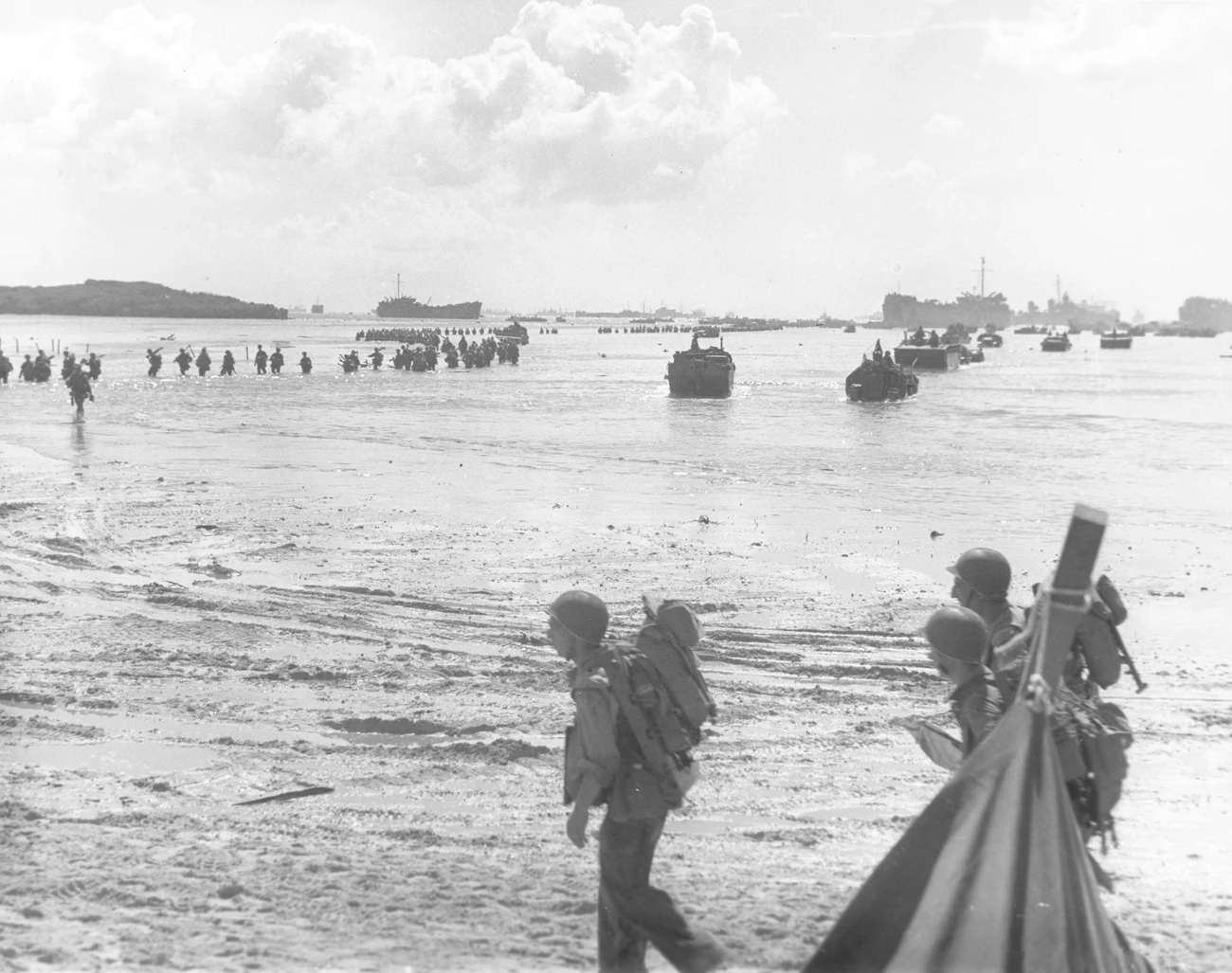
US Army Signal Corps Collection of Photographs #210232, Book 1
The III Amphibious Corps tasked with the recapture of Guam was made up of three major units: the Third Marine Division, which landed at Assan Beach; the 1st Provisional Marine Brigade, which landed at Hågat Beach; and the 77th U.S. Army Infantry Division, which served as the Corps' reserve. The campaign's operation plan called for the two Marine divisions to function as assault troops on W-Day, with the 305th Regimental Combat Team (RCT), 77th Division acting as the 1st Brigade's direct reserve for the first few days of battle. The rest of the reserves would remain afloat until the beachheads had been established, then land at Hågat Beach. [1]
To do this, however, the 77th Division would have to cross what some naval officers called "the toughest reef in the Pacific War." [2]
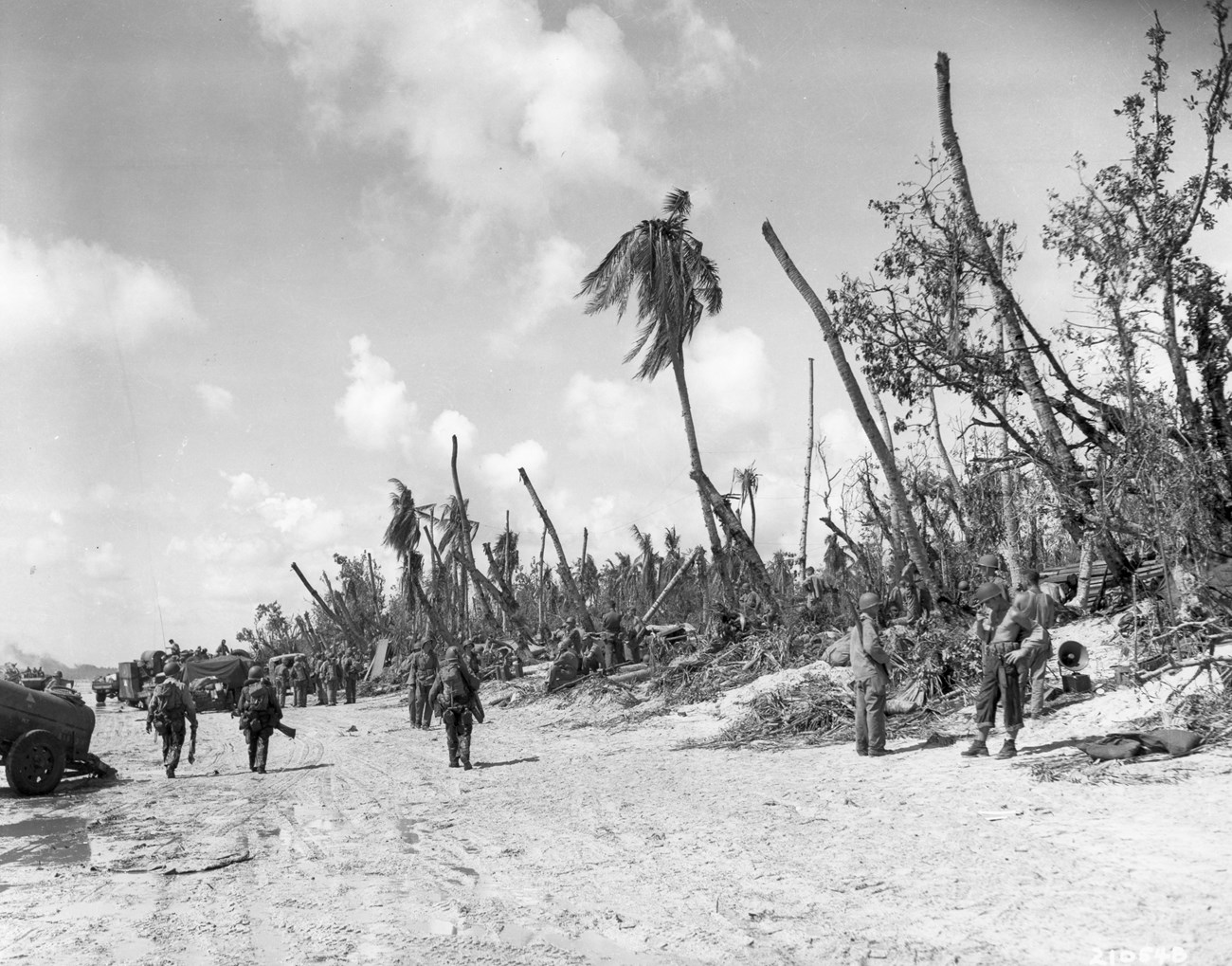
US Army Signal Corps Collection of Photographs #210548, Book 1
The 305th Regimental Combat Team Comes Ashore
The 305th RCT (later designated the 2nd Battalion) was originally intended to land on Hågat Beach midmorning of July 21, 1944—W-Day—but despite fierce fighting, the Brigade's commander, Brigadier General Lemuel C. Shepherd, did not order them to come ashore as planned. The RCT spent hours circling in small landing crafts (LCPVs or Higgins Boats) in Guam's oppressive heat and humidity. For many of the infantrymen, Guam would be their first experience in combat, and the combination of nerves and the waves left them seasick. [3]
They were finally ordered to land at 2:04 p.m., but the battalion immediately ran into problems. Hågat Beach was surrounded by a wide reef, shallow enough to prevent LCVPs from passing over, but deep enough for trucks to be useless. The only vehicles that could pass over the reef were LVTs (commonly known as Amtracs) and DUKWs (also called Ducks). To transfer to shore, soldiers had to clamber from their transport vessels into the LCVPs, which took them to the reef's edge, then transfer into a LVT or DUKW to be taken the rest of the way to shore. [4]
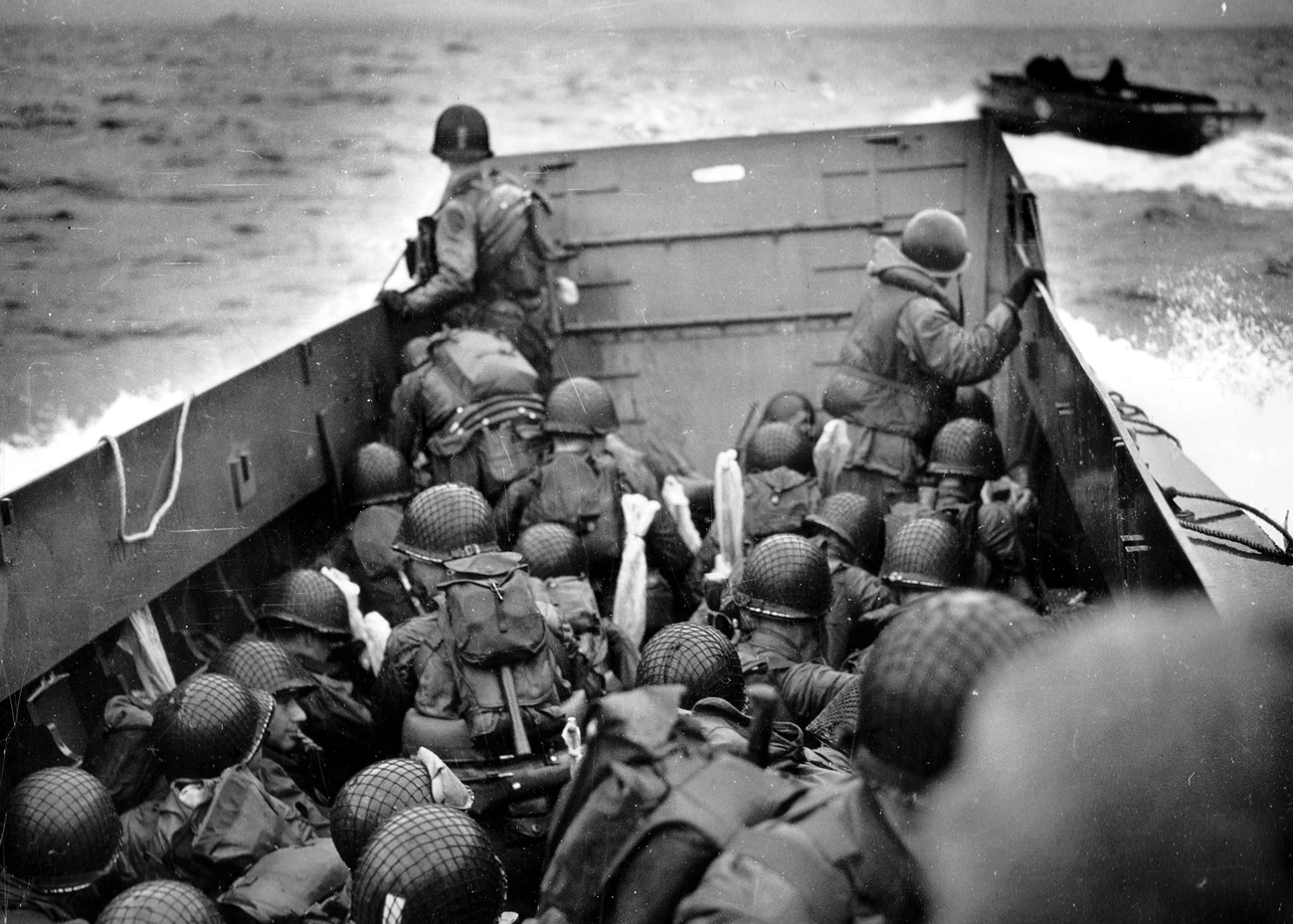
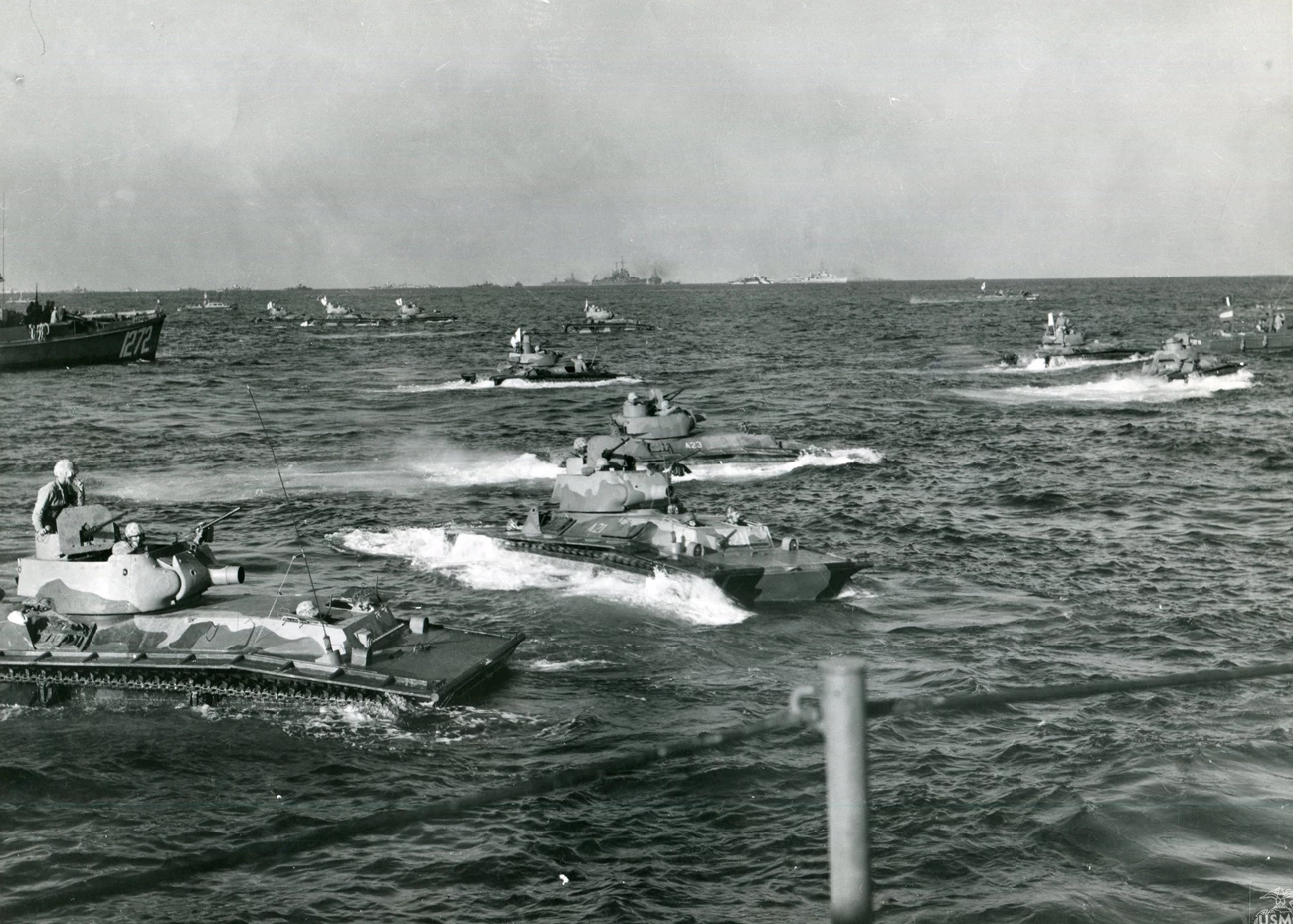
Left image
LCVPs (Landing Craft, Vehicle, Personnel) were a shallow-draft, flat-bottom boat with a ramp at the bow that could be lowered to allow soldiers to quickly exit the boat. Here, soldiers crouch in an LCVP before landing on Omaha Beach, Normandy, on D-Day.
Credit: National Archives 26-G-2340
Right image
LVT (Landing Vehicle, Tracked) were armored, amphibious tractors with two rows of tracks covered in cleats that could move over sand, mud, or coral. Here, LVTs transport Marines to the shore of Iwo Jima.
Credit: USMC Photograph, from the Thayer Soule Collection (COLL/2266)
The 305th was an Army battalion, however, and unlike the Marines, the Army did not have Amtracs. The 1st Provisional Marine Brigade had used LVTs to transport its soldiers to shore, but the vehicles had taken a heavy hit during the morning's fighting. Of the thirty-seven LVTs assigned to the Brigade, twenty-four were put out of commission on the first day by either Japanese fire, damage to the treads, or mechanical trouble. By the time the 305th RCT was ready to land, the Brigade's remaining LVTs were needed to transport badly needed supplies to shore and could not be spared. [5]
Instead, the soldiers were dropped off at the reef's edge, then had to wade the remaining 400 yards to shore across jagged coral heads, potholes, and shell craters while carrying their gear. At its shallowest, the water was only waist deep, but men frequently slipped or stepped in holes and found themselves floundering in water over their heads, soaking both them and their equipment. The beach was still under direct fire from Imperial Japanese artillery positioned on the high ground above the beach, but the Marines' advance prevented them from turning those guns on the men wading to shore. Despite the logistical challenges, the 305th RCT made it to White Beach, reformed their ranks, and set up a defensive position by nightfall. [6]
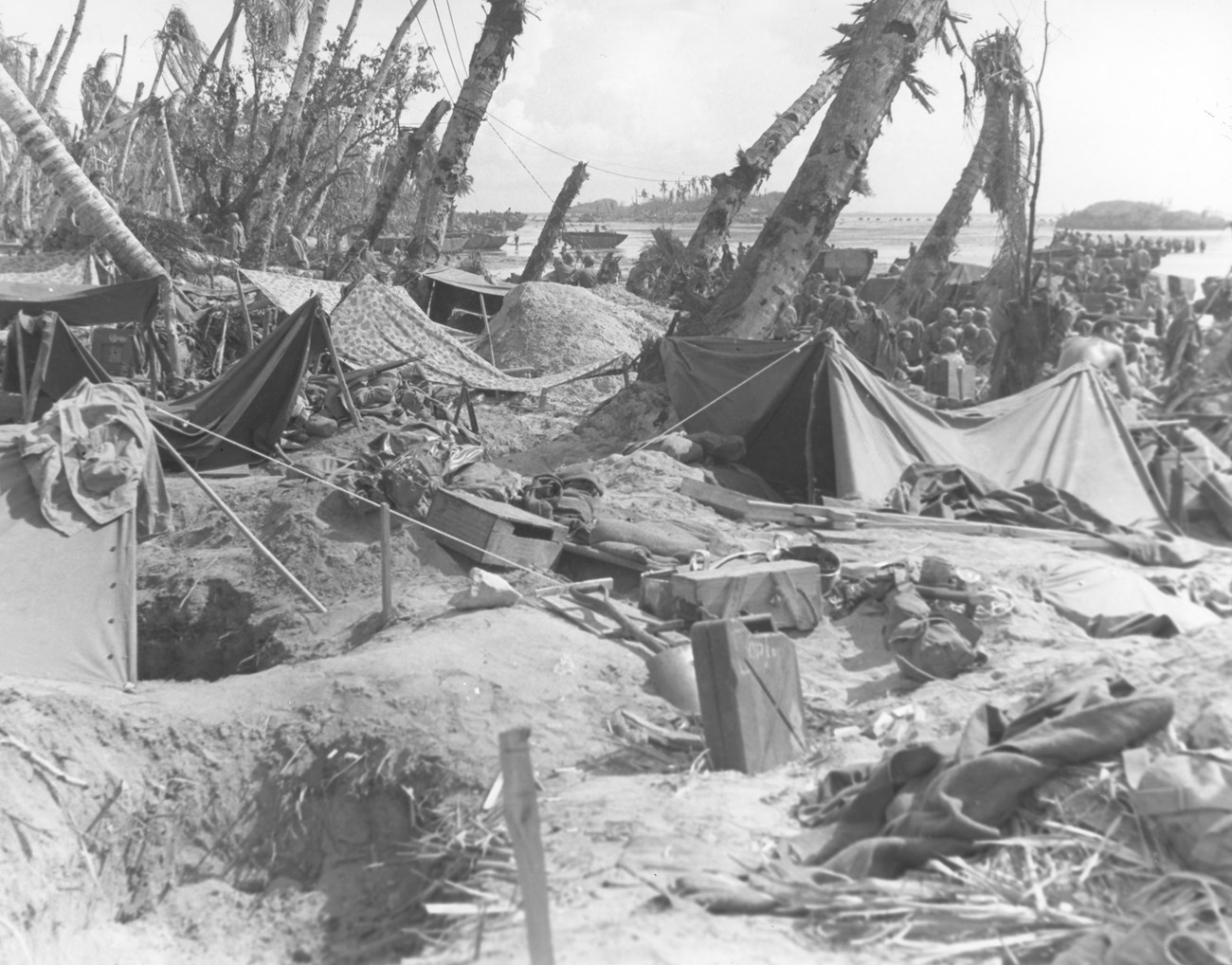
US Army Signal Corps Collection of Photographs #210559, Book 1
The Rest of the 305th Regiment Lands
The Marines of the 1st Brigade had made tremendous progress on W-Day, but Shepherd anticipated that Imperial Japanese troops would launch a counterattack once night fell, and he wanted as many of his reserves as possible on shore to help counter it. In spite of the lack of vehicles, at 2:30 p.m., Shephard ordered Colonel Vincent Tanzola, the 305th Regiment's commander, to land the rest of his troops immediately. The 1st Brigade had been plagued with communication issues all day, however, and it took an hour for the order to reach Tanzola. Then, when the 1st Battalion requested clearance to land from the Navy control boat, the landing instructions had also been delayed, and the landing crafts were not allowed to proceed to the reef until 5:30 p.m. [7]
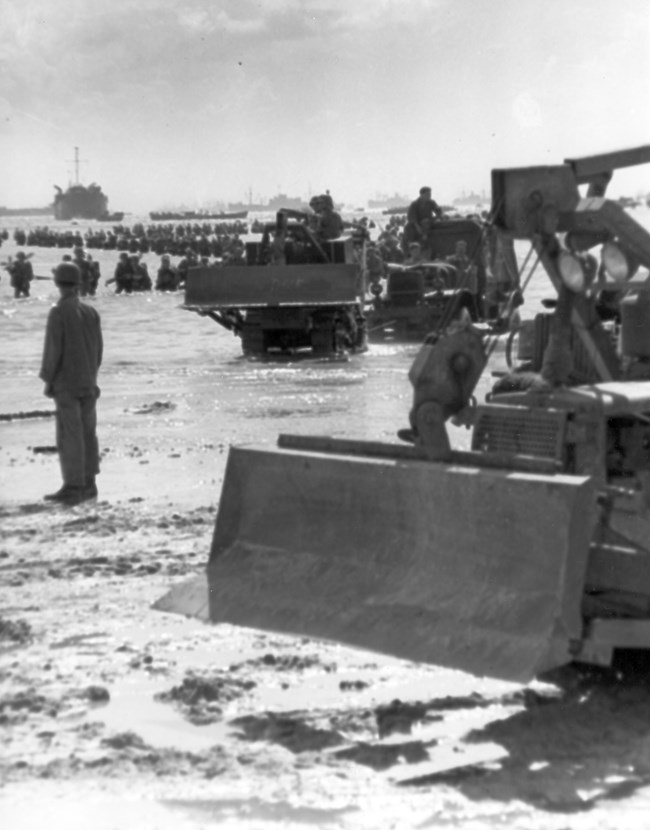
Concerned about the potential dangers of landing his men in the swiftly approaching darkness and rising tide, Tanzola requested that the landing be postponed until the following morning. Shepherd's response was curt: "Land your CT at once in accordance with previous instructions." [8]
The journey across the reef was even more treacherous at night. There were still no available Amtracs, so the 1st Battalion waded through chest-deep water, and even swam at times. In the darkness, many of the soldiers lost their way, only narrowly avoiding coming ashore in Japanese-held territory. Soldiers were carrying as much as fifty pounds of equipment: a rifle, bayonet, grenade launcher, two bandoleers of ammunition, a bag full of rifle grenades, a pouch of hand grenades, steel helmet and liner, gas mask, life belt, two canteens of water, a first aid pack, wire cutters, and a machete.
- Duration:
- 20.9 seconds
To reach the Hågat Beachhead, the 77th U.S. Army Infantry Division had to wade 400 yards across what some naval officers called "the toughest reef in the Pacific War." Credit: National Archives 428-NPC-5107
It was dark when the 1st Battalion finally reached the beach, disorganized and several hundred yards south of their intended landing site. Two-thirds of the men made it to their assembly spot inland, but because of the anticipated Japanese counterattack, military police would not allow anyone leave the beach after 9:30 p.m. The last troops ashore had to spend the night on the beach. The night's ordeal did not end at dry land. In the early hours of the morning, a small group of Japanese infiltrators attacked Company A and B. Seven infantrymen were killed in the fight, and another ten were wounded, but they defended their position, killing twenty Japanese soldiers. [9]
The 3rd Battalion did not start to land until the wee hours of the morning. A false report of an enemy submarine had forced their transport vessel out to sea until 9:30 p.m., and it was 2:00 a.m. before the first soldiers reached the reef. They did, however, have more help than the other two battalions. Tanzola was able to find five LVTs and guides to help many of his remaining men to shore. Even so, it wasn't until 3:30 a.m. that the majority of the battalion reached the beach, and the last stragglers did not make it to dry land until 6:00 a.m. [10]
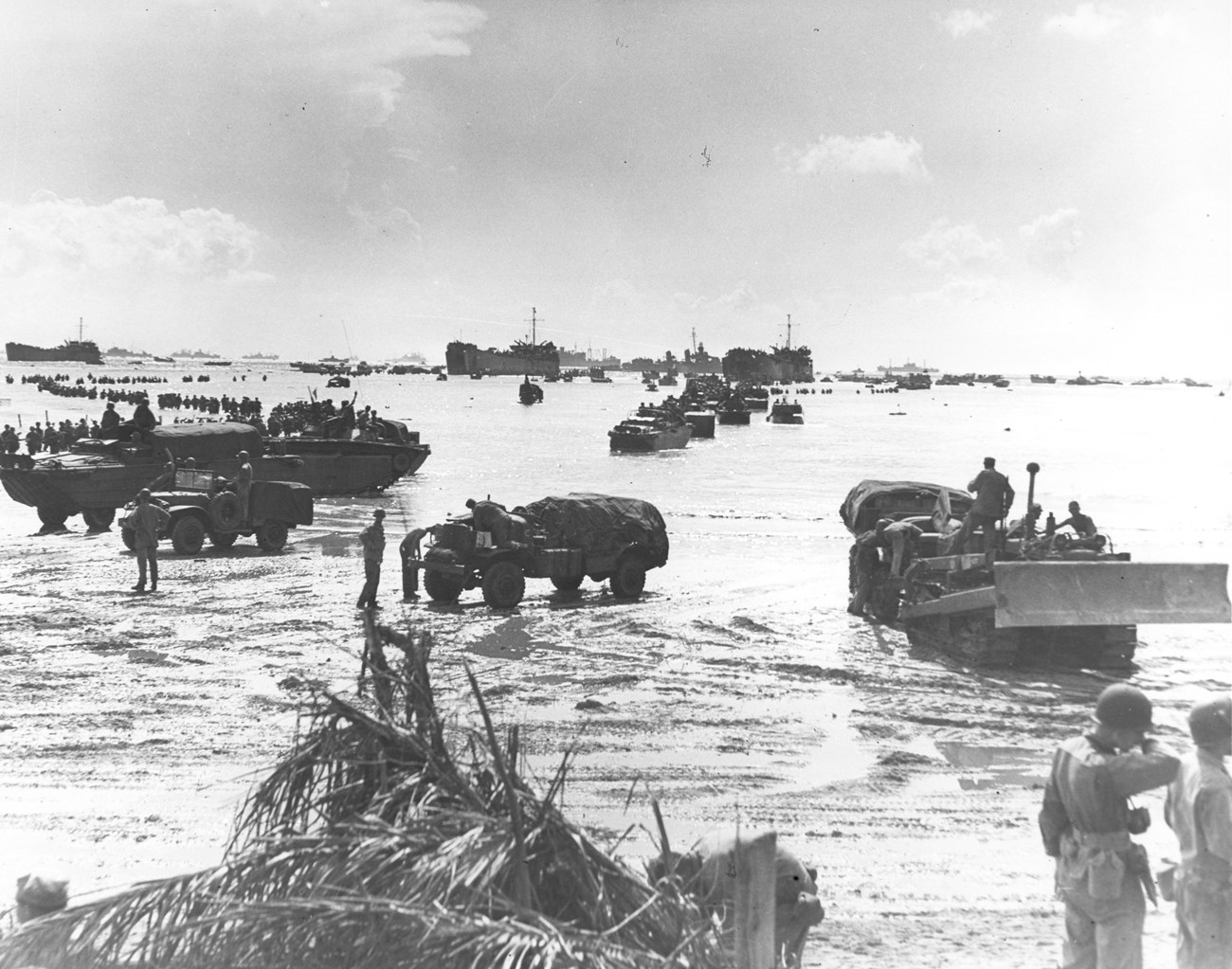
US Army Signal Corps Collection of Photographs #210562, Book 1
The 306th Regiment Wades Ashore
Despite the difficult journey and long night, the 305th Regiment advanced to the front lines the following morning. While the RCT joined the 2nd Battalion, 4th Marines as the Brigade's reserve, the 1st and 3rd Battalions quickly began securing the defensive perimeter running from Maanot Pass to the ridges overlooking the Orote Peninsula. [11] By the evening, it was clear that even though it was not fully secure, Imperial Japanese troops would be unable to recapture the beachhead. Major General Roy Geiger, overall commander of the III Amphibious Corps, turned his attention towards the 1st Provisional Marine Brigade's next objective: capturing Orote Peninsula, home to a strategically important airfield and the entrance to Apra Harbor. This meant that the rest of 77th Infantry Division needed to land and take control of the perimeter south of Orote Peninsula. [12]

National Park Service via Guam: A Biogeographic and Maritime Cultural Landscape Exploration of a WWII Amphibious Battlefield
The 306th Regiment began landing midday on July 23. The 1st Brigade's Amtracs were still needed to transport supplies, and while the Regiment had been assigned sixty DUKWs, they were reserved for moving cargo and light artillery. Having learned the lesson from the 305th's experience, the 306th attempted to land at low tide, but were delayed until after the tide had started to come in. Most of the regiment's vehicles were flooded, destroying the radio sets and other communication equipment onboard. One medium tank simply disappeared into a large shell hole.
Robert Dillon, a member of the 306th Regiment, described the landing experience:
We were on the ninth wave on Higgins boats. We went around and around in circles until our wave hit. … I was so damn sick I could have jumped. I was going to jump the next time we came near shore again; seasick. … I had to rig my jeep up with a snorkel. They let the ramp down and I had to drive my jeep into water about chest high, underwater. When it hit on land it only went about 50 feet and conked out because of condensation.[13]
The entire 306th Regiment was able to make it to shore before dark, and by mid-afternoon the following day, the 77th Division had relieved the 4th Marines and assumed control of the entire perimeter east of Old Hågat Road. [14]
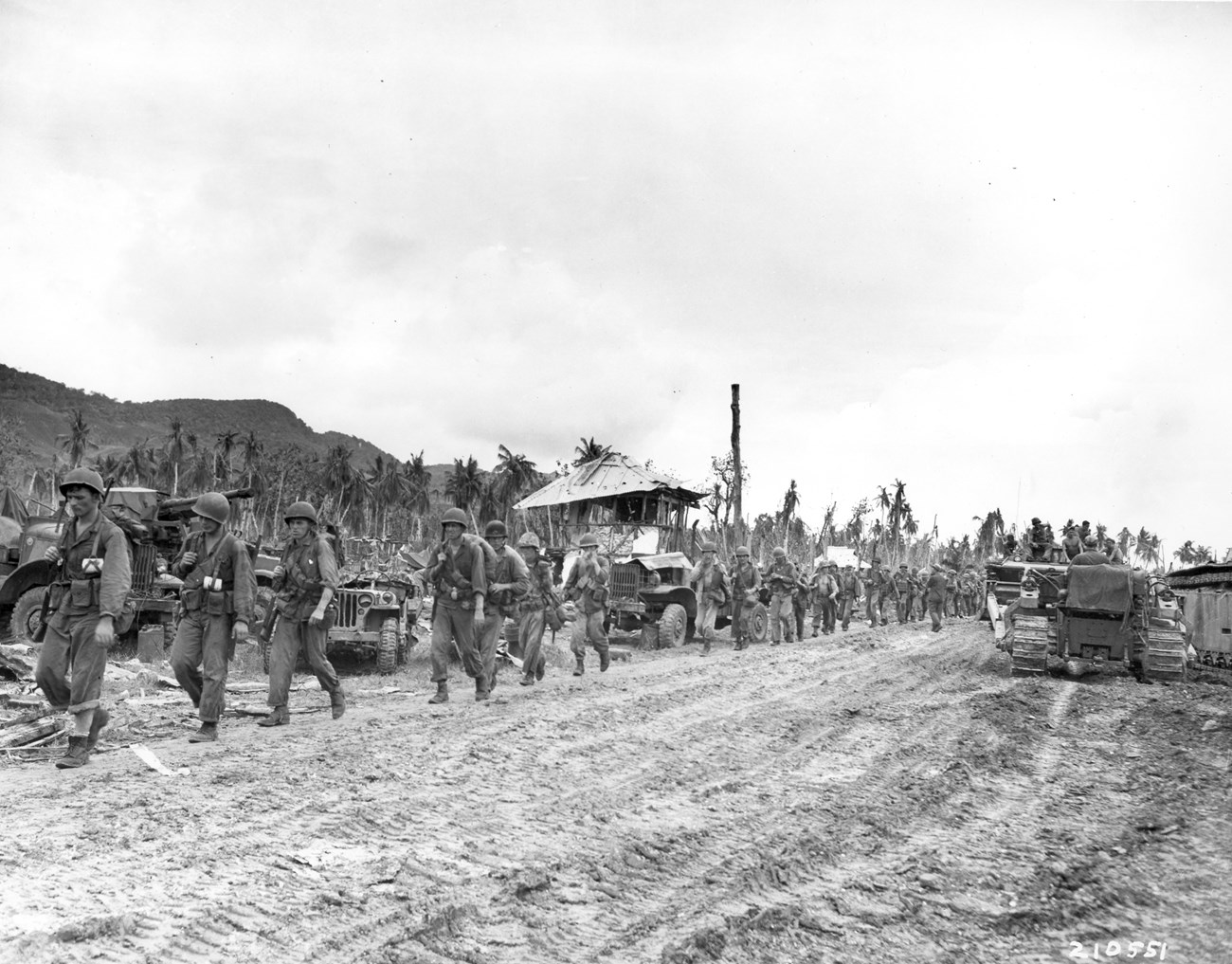
US Army Signal Corps Collection of Photographs #210551, Book 1
The Last Troops Land
By 1:00 p.m., July 24, Geiger was confident enough of the situation on both beaches to begin landing the 307th Regiment, his last remaining major reserve force. Heavy ground swells caused by a storm complicated their landing, and two soldiers drowned trying to board their landing craft, but by nightfall, the 307th had landed. It had taken four days, but all 17,956 men of the 77th Division were ashore. [15]
While they served as the reserve during the landing, the Army played a critical role during the rest of the Battle of Guam. During the final phase of combat, the 77th Division, along with the Third Marines, captured the northern half of the island and defeated the remainder of the Imperial Japanese Army. However, throughout the campaign, the division suffered from equipment shortages, most critically the communications gear which had been destroyed during their difficult and wet journey to shore. [16]
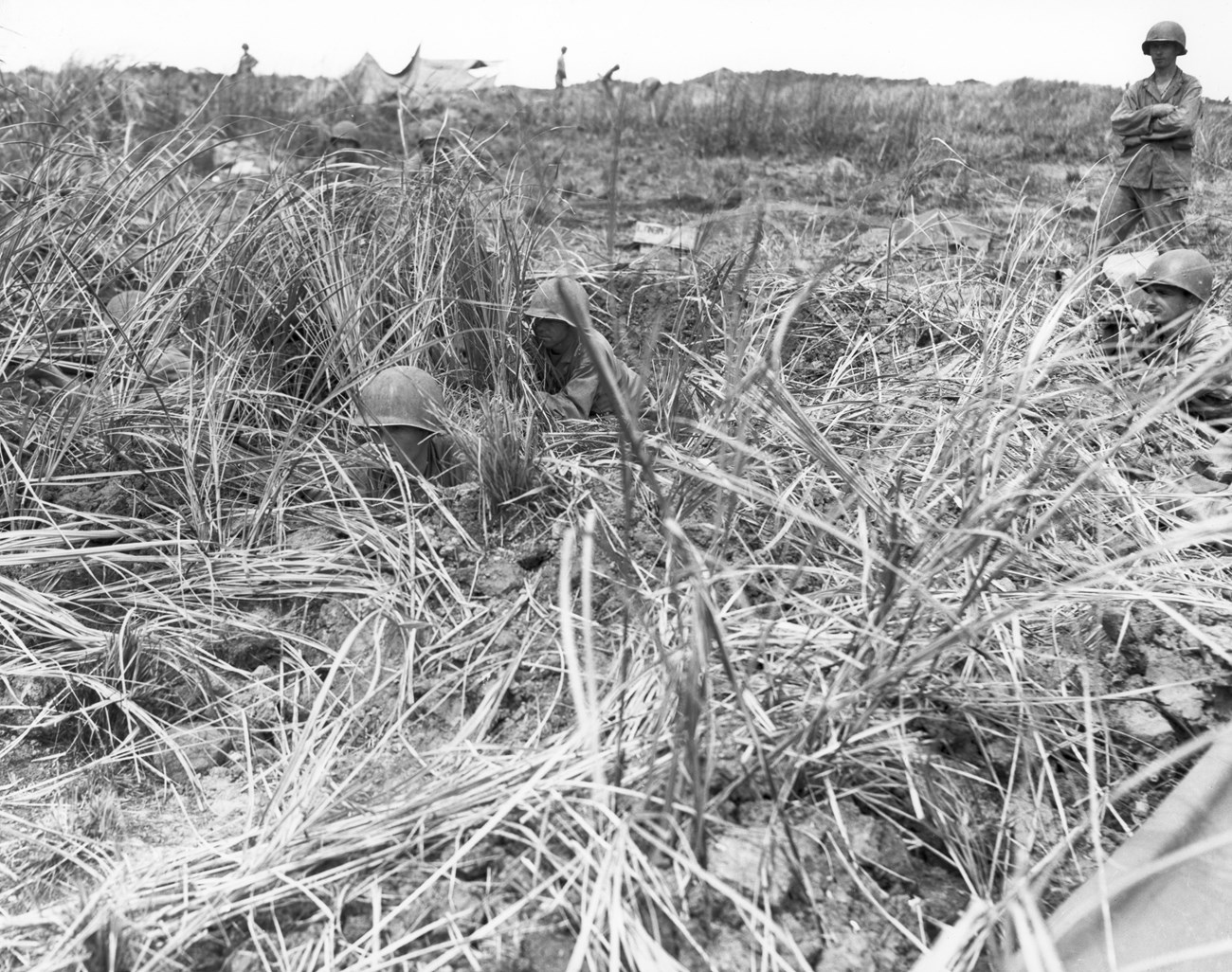
US Army Signal Corps Collection of Photographs #272342 Book 1
[1] Philip A. Cowl, Campaign in the Marianas, United States Army in World War II (Washington, D.C.: Center of Military History United States Army, 1960), 345; Harry A. Gailey, The Liberation of Guam, 21 July-10 August 1944 (Novato, CA : Presidio, 1988), 107–8; Maj O. R. Lodge, The Recapture of Guam (Headquarters: Historical Branch, G-3 Division, U.S. Marine Corps, 1954), 31–32; Robert F. Rogers, Destiny’s Landfall: A History of Guam, Revised Edition (Honolulu: University of Hawaiʻi Press, 2011), 170.
[2] Lodge, The Recapture of Guam, 72.
[3] Gailey, The Liberation of Guam, 108; Lodge, The Recapture of Guam, 56.
[4] Gailey, The Liberation of Guam, 99–100; Vida Germano and James Oelke Farley, "War in the Pacific National Historical Park: Cultural Landscapes Inventory, National Park Service" (NPS Pacific West Regional Office, 2013), 35; Lodge, The Recapture of Guam, 48; Henry I. Shaw, Bernard C. Nalty, and Edwin T. Turnbladh, Central Pacific Drive, vol. III, History of U.S. Marine Corps Operations in World War II (Headquarters: Historical Branch, G-3 Division, U.S. Marine Corps, 1966), 452.
[5] Gailey, The Liberation of Guam, 108; Lodge, The Recapture of Guam, 56; Cyril J. O’Brien, Liberation: Marines in the Recapture of Guam, Marines in World War II Commemorative Series (History and Museums Division, Headquarters, U.S. Marine Corps, 1994), 12; Shaw, et al, Central Pacific Drive, 473.
[6] Cowl, Campaign in the Marianas, 346; Gailey, The Liberation of Guam, 108; Lodge, The Recapture of Guam, 56; Shaw, et al, Central Pacific Drive, 476.
[7] Cowl, Campaign in the Marianas, 346–47; Gailey, The Liberation of Guam, 109; Lodge, The Recapture of Guam, 56–57; Shaw, et al, Central Pacific Drive, 477.
[8] Lodge, 57.
[9] Cowl, Campaign in the Marianas, 346–47; Gailey, The Liberation of Guam, 109–12; Lodge, The Recapture of Guam, 56–58; Shaw, et al, Central Pacific Drive, 477.
[10] Cowl, Campaign in the Marianas, 347; Gailey, The Liberation of Guam, 110–11; Lodge, The Recapture of Guam, 57–58; Shaw, et al, Central Pacific Drive, 447.
[11] Lodge, The Recapture of Guam, 66; Shaw, et al, Central Pacific Drive, 494.
[12] Cowl, Campaign in the Marianas, 351, 354–55; Lodge, The Recapture of Guam, 70; Shaw, et al, Central Pacific Drive, 496.
[13] Dillon, Robert P. "Oral History Interview with Robert Dillon." By Richard Misenhimer. November 4, 2004. The National Museum of the Pacific War, Center for Pacific War Studies. Accessed 3 March 2025.
[14] Cowl, Campaign in the Marianas, 355; Gailey, The Liberation of Guam, 117–18; Lodge, The Recapture of Guam, 70–73; Shaw, et al, Central Pacific Drive, 497.
[15] Cowl, Campaign in the Marianas, 355–56; Gailey, The Liberation of Guam, 118; Lodge, The Recapture of Guam, 73; Rogers, Destiny’s Landfall, 170.
[16] Cowl, Campaign in the Marianas, 380–473; Gailey, The Liberation of Guam, 119.
Learn More
-
 Agat Unit
Agat UnitExplore remains of fortifications used by Imperial Japanese troops during the Battle of Guam at the War in the Pacific's Agat Unit.
-
 Underwater Resources
Underwater ResourcesRemains of the Battle of Guam can still be found just offshore of the landing beaches.
-
 Hågat Beach During the Battle of Guam
Hågat Beach During the Battle of GuamOn W-Day, the 1st Provisional Marine Brigade landed at Hågat Beach, establishing the southern beachhead.
-
 Battle of Guam
Battle of GuamOn July 21, 1944, American forces landed at Guam, kicking off a 21-day fight to retake the island.
-
 The Capture of Mount Alifan
The Capture of Mount AlifanLooming over Hågat Beach, Mount Alifan had to be captured before the southern beachhead would be secure.
